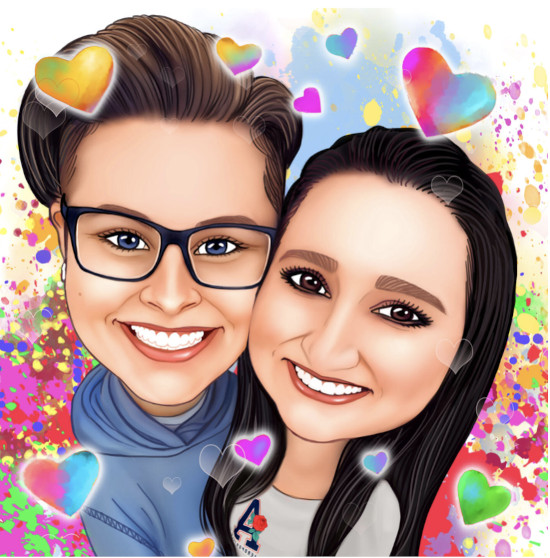As an art form, caricature has significantly influenced how LGBTQ+ individuals are portrayed in media over time. It involves exaggeration to create a humorous or satirical representation, but unfortunately, when applied to LGBTQ+ individuals, it often reinforces stereotypes and harmful misrepresentations.
In mainstream media, achieving authentic LGBTQ+ representation has been a persistent challenge. This gap has led to a flourishing subculture of fanfiction and headcanons, where fans craft alternative narratives showcasing LGBTQ+ characters in all their complexity. However, progress in portraying LGBTQ+ individuals within mainstream entertainment has been slow and, at times, misguided. This article delves into the intricate journey of queer representation, acknowledging the strides made while recognizing there is still much ground to cover.

The Evolution of LGBTQ+ Cartoon Characters Reflects Significant Progress Made
The database observes the ‘historical representation of individuals identifying as lesbian, gay, bisexual, transgender, intersex, asexual, and other sexual and gender minorities,’ confirmed in animated children’s television programs within the United States.’ The statement indicates 259 LGBTQ+ characters in children’s animated programming.
SuperTed, which premiered on the Disney Channel in 1983, was the pioneer in featuring an LGBTQ+ character in an animated show, followed by Gargoyles in 1994. Although progress has been evident, a significant advancement has occurred in the last decade. Insider provides an insightful overview of LGBTQ+-coded characters from the 1900s, the impact of the Hays Code, the portrayal of queer stereotypes as villains, persistent LGBTQ+ tropes, and more.
● Pre-20th Century: LGBTQ+ representation was minimal, often destructive or absent due to societal norms and laws.
● Early 20th Century: LGBTQ+ characters were portrayed as stereotypes, reinforcing negative views.
● Mid-20th Century: Harmful stereotypes persisted, perpetuating societal prejudices.
● 1970s – 1980s: LGBTQ+ activism began, challenging stereotypes but still often depicted as tragic figures.
● 1990s – 2000s: Increased LGBTQ+ visibility, but with persistent stereotypes.
● Late 2000s – Early 2010s: Media started featuring LGBTQ+ characters with more depth and authenticity.
● Mid-2010s – Present: LGBTQ+ representation became diverse, authentic, and multi-dimensional.
Evolving LGBTQ+ Representation in Hollywood: A Journey Through Decades of Film
In the earlier era of Hollywood, the stringent Hays Code banned explicit portrayals of homosexuality in movies for a remarkable three decades. A notable trend emerged during this period: the rise of queer-coded villains. Post this era, gay characters began to make appearances in films, often woven into tragic narratives, exemplified by the poignant 1961 movie “The Children’s Hour.”
Although LGBTQ+ representation remained notably scarce in the subsequent decades, a cultural shift unfolded during the 1970s with the surge of queer camp, gaining traction notably through the widespread popularity of “The Rocky Horror Picture Show” and the unconventional films of John Waters. A turning point arrived in the 1990s with the flourishing of the New Queer Cinema, spearheaded by a cadre of independent filmmakers, many of whom identified as gay. This movement was characterized by creating fluid, empathetic stories that authentically portrayed the lives and experiences of these unique individuals.
The Many Faces of Queer Representation
Queer representation is now taking various forms, reflecting the complexity of the LGBTQ+ community. However, this diversity is a double-edged sword. While representation has broadened, it isn’t always positive. Negative stereotypes and gay caricatures persist, perpetuating harmful misconceptions about LGBTQ+ individuals.
The Complexities of Representation
The complexities of representation lie not only in its diversity but also in its potential to evoke different emotional responses. Accurate and compelling portrayals can sometimes distress the community they aim to represent. The challenge lies in finding a delicate balance that respects the diversity of experiences within the LGBTQ+ community.
The evolution of LGBTQ+ representation in media is a complex journey marked by progress, pitfalls, and perseverance. Fanfiction and headcanons emerged as powerful tools to bridge the representation gap, illustrating the desire for diverse and authentic characters. However, mainstream media is still catching up, and the path to authentic and positive representation is nuanced and challenging. It demands a deep understanding of the LGBTQ+ community’s diverse facts and experiences, ensuring that every representation contributes to a more inclusive and empathetic world.
